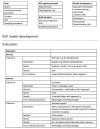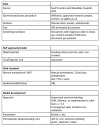Using clinical Natural Language Processing for health outcomes research: Overview and actionable suggestions for future advances
- PMID: 30368002
- PMCID: PMC6986921
- DOI: 10.1016/j.jbi.2018.10.005
Using clinical Natural Language Processing for health outcomes research: Overview and actionable suggestions for future advances
Abstract
The importance of incorporating Natural Language Processing (NLP) methods in clinical informatics research has been increasingly recognized over the past years, and has led to transformative advances. Typically, clinical NLP systems are developed and evaluated on word, sentence, or document level annotations that model specific attributes and features, such as document content (e.g., patient status, or report type), document section types (e.g., current medications, past medical history, or discharge summary), named entities and concepts (e.g., diagnoses, symptoms, or treatments) or semantic attributes (e.g., negation, severity, or temporality). From a clinical perspective, on the other hand, research studies are typically modelled and evaluated on a patient- or population-level, such as predicting how a patient group might respond to specific treatments or patient monitoring over time. While some NLP tasks consider predictions at the individual or group user level, these tasks still constitute a minority. Owing to the discrepancy between scientific objectives of each field, and because of differences in methodological evaluation priorities, there is no clear alignment between these evaluation approaches. Here we provide a broad summary and outline of the challenging issues involved in defining appropriate intrinsic and extrinsic evaluation methods for NLP research that is to be used for clinical outcomes research, and vice versa. A particular focus is placed on mental health research, an area still relatively understudied by the clinical NLP research community, but where NLP methods are of notable relevance. Recent advances in clinical NLP method development have been significant, but we propose more emphasis needs to be placed on rigorous evaluation for the field to advance further. To enable this, we provide actionable suggestions, including a minimal protocol that could be used when reporting clinical NLP method development and its evaluation.
Keywords: Clinical informatics; Epidemiology; Evaluation; Information extraction; Mental Health Informatics; Natural Language Processing; Public Health; Text analytics.
Copyright © 2018 The Authors. Published by Elsevier Inc. All rights reserved.
Conflict of interest statement
The authors declare that there are no conflicts of interest.
Figures


References
Publication types
MeSH terms
Grants and funding
LinkOut - more resources
Full Text Sources
Miscellaneous

